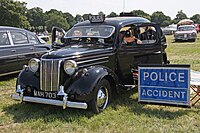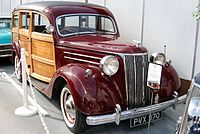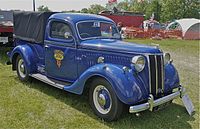
The Ford Anglia is a small family car that was designed and manufactured by Ford UK. It is related to the Ford Prefect and the later Ford Popular. The Anglia name was applied to various models between 1939 and 1967. In total, 1,594,486 Anglias were produced. It was replaced by the Ford Escort.
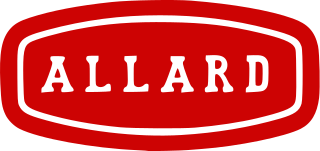
Allard Motor Company Limited was a London-based low-volume car manufacturer founded in 1945 by Sydney Allard in small premises in Clapham, south-west London. Car manufacture almost ceased within a decade. It produced approximately 1900 cars before it became insolvent and ceased trading in 1958. Before the war, Allard supplied some replicas of a Bugatti-tailed special of his own design from Adlards Motors in Putney.

The Ford Galaxie is a car that was marketed by Ford in North America from the 1959 to 1974 model years. Deriving its nameplate from a marketing tie-in with the excitement surrounding the Space Race, the Galaxie was offered as a sedan within the full-size Ford range throughout its production run. In the full-size segment, the model line competed against the Chevrolet Impala and Dodge Polara.
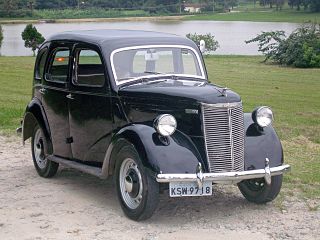
The Ford Prefect is a line of British cars which was produced by Ford UK between 1938 and 1961 as an upmarket version of the Ford Popular and Ford Anglia small family cars. It was introduced in October 1938 and remained in production until 1941. Returning to the market in 1945, it was offered until 1961. The car progressed in 1953 from its original perpendicular or "sit-up-and-beg" style to a more modern three-box structure. Some versions were also built and sold by Ford Australia.

The Ford Falcon is a full-size car that was manufactured by Ford Australia from 1960 to 2016. From the XA series of 1972 onward, each Falcon and range of derivates have been designed, developed, and built in Australia, following the phasing out of the American-influenced Falcon of 1960 to 1971, which had been re-engineered locally as the XK to XY series for the harsher Australian conditions. The luxury-oriented Ford Fairmont model joined the range from 1965. Luxury long-wheelbase derivative versions called the Ford Fairlane and LTD arrived in 1967 and 1973 respectively with production ending in 2007.

The Jaguar S-Type is an executive car that debuted at the 1998 Birmingham Motor Show and was marketed by Jaguar for model years 1999–2007, reviving the nameplate of the company's 1963–68 S-Type as a four-door notchback saloon. The S-Type received a mild facelift for the 2002 model year and again in 2004. The S-Type was discontinued in late 2007 and replaced by the XF.

The Holden Torana is a mid-sized car that was manufactured by Holden from 1967 to 1980. The name apparently comes from a word meaning "to fly" in an unconfirmed Aboriginal Australian language. The original HB series Torana was released in 1967 and was a four-cylinder compact vehicle closely based on the British Vauxhall Viva HB series of 1966–1970.

The Ford Zephyr is an executive car manufactured by Ford of Britain from 1950 until 1972. The Zephyr and its luxury variants, the Ford Zodiac and Ford Executive, were the largest passenger cars in the British Ford range from 1950 until their replacement by the Consul and Granada models in 1972.

The Ford Fairmont is a model line of compact cars that was manufactured by Ford from the 1978 to 1983 model years. The successor of the Ford Maverick, the Fairmont marked the third generation of compact sedans sold by Ford in North America. Initially slotted between the Pinto and Granada within the Ford line, the Fairmont was later marketed between the Ford Escort and Ford LTD. In contrast to its predecessor, the model line was offered as a two-door notchback sedan, two-door coupe, four-door sedan, and five-door station wagon. Though never sold as a Lincoln, Mercury sold a divisional counterpart of the Fairmont as the Mercury Zephyr.
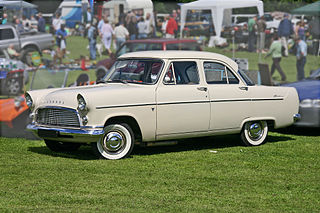
The Ford Consul is a car that was manufactured by Ford of Britain from 1951 until 1962. The name was later revived for a model produced by Ford in both the UK and in Germany from 1972 until 1975.

The MGB is a two-door sports car manufactured and marketed from 1962 until 1980 by the British Motor Corporation (BMC), later the Austin-Morris division of British Leyland, as a four-cylinder, soft-top sports car. It was announced and its details first published on 19 September 1962. Variants include the MGB GT three-door 2+2 coupé (1965–1980), the six-cylinder sports car and coupé MGC (1967–69), and the eight-cylinder 2+2 coupé, the MGB GT V8 (1973–76).

The Vauxhall Cresta is a British automobile which was produced by Vauxhall from 1954 to 1972. The Cresta was introduced in 1954 as an upmarket version of the Vauxhall Velox, itself a six-cylinder version of the Vauxhall Wyvern. The Cresta models were the E (1954–1957), PA (1957–1962), PB (1962–1965) and PC (1965–1972). The Viscount (1966–1972) was an upmarket Cresta PC.
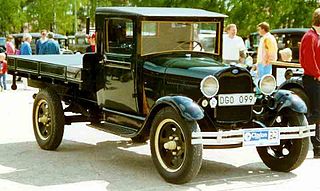
Ford Model AA is a truck from Ford. As the Model T and TT became obsolete and needed to be replaced, Henry Ford began initial designs on the Model A and Model AA in 1926. Basic chassis layout was done rapidly and mechanical development was moved forward quickly. Body design and style was developed and then outsourced to various body manufacturers, including Briggs and Murray. The designs of the Model A shared parts and materials with the Model AA Ford, notably the body, engine and interior. The AA usually received plainer interiors than their car counterparts. The Model AA followed similar design changes to the Model A during the AA's four years in production, often delayed anywhere from three to nine months. The mechanical changes and upgrades were done during production of the vehicles. Body changes that occurred between 1929 and 1930 were also integrated into AA production, but leftover parts were used longer in the heavy commercial trucks.

The Holden Commodore (VB) is a mid-size car that was produced by Holden, from 1978 to 1980. It was the first iteration of the first generation of the Holden Commodore.

The Holden Caprice (VQ) and Holden Statesman (VQ) were Holden's top-of-the-line luxury sedans produced between 1990 and 1994. It was the first Statesman to be based on the Commodore line. The rear end was an all-new design, with independent rear suspension.

The Ford Falcon (AU) is a full-size car that was produced by Ford Australia from 1998 to 2002. It was the sixth generation Ford Falcon and also included the Ford Fairmont (AU)—the luxury-oriented model range. The AU series replaced the EL Falcon and was constructed on the (at the time) new EA169 platform which continued to harbour Falcon models until 2010 when the BF wagon was discontinued, and Ford Territory models until 2011. The AU series was replaced by the updated BA series.

The Ford Falcon (ED) is a full-size car that was produced by Ford Australia from 1993 to 1994. It was the third iteration of the fifth generation of the Falcon and also included the Ford Fairmont (ED)—the luxury-oriented version.

The European Ford Granada is an executive car manufactured by Ford Europe from 1972 until 1994.
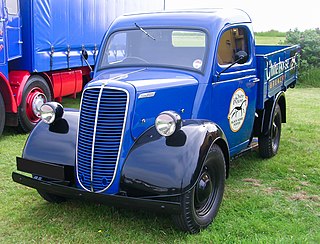
The Fordson E83W,, is a 10 cwt light commercial vehicle that was built by Ford of Britain at the Ford Dagenham assembly plant between 1938 and 1957. The van was sold in Australia as the Ford Ten-Ten, and the E83W was available in various forms around much of the world as Britain strove to export after World War II. In some countries, the 'cowl and chassis' only was imported and local bodies built.
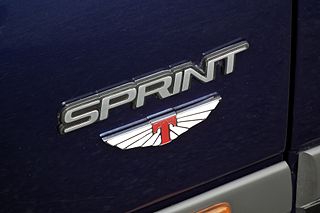
Tickford Vehicle Engineering (TVE) was a company responsible for numerous automotive projects and upgrades for Ford Australia between 1991 and 2002. In 1999, TVE setup Ford Tickford Experience (FTE) as a competitor to Holden Special Vehicles (HSV). In 2002, the operations changed to Ford Performance Vehicles (FPV), coinciding with Tickford's global operations being bought out by Prodrive.


